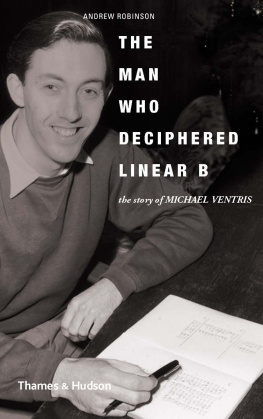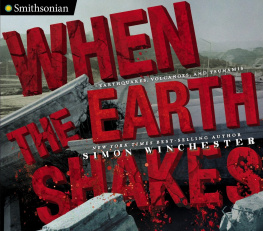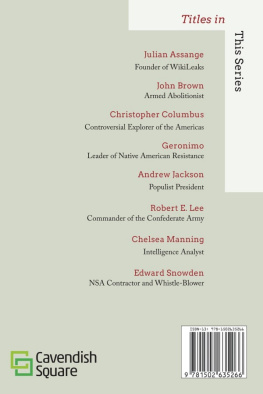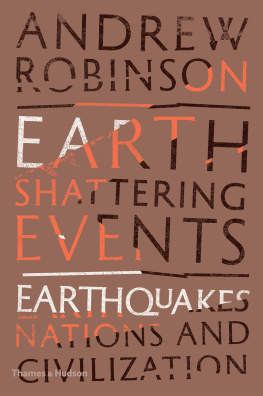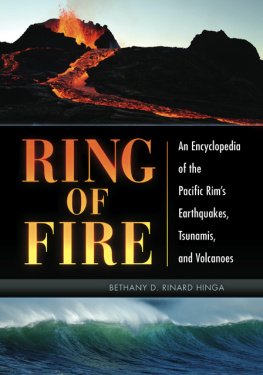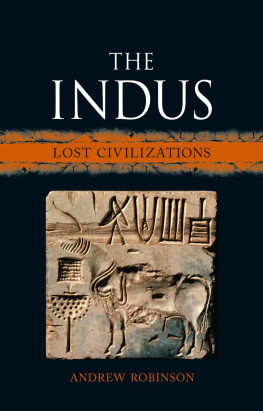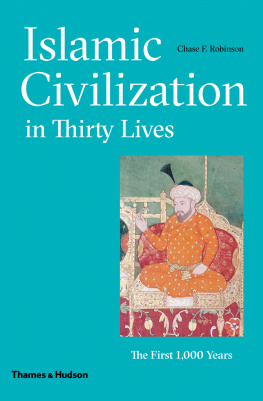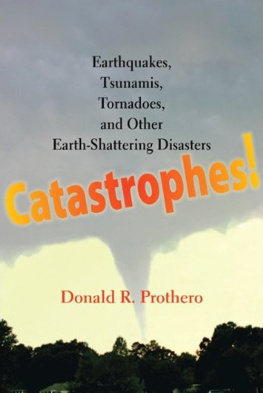Andrew Robinson - Earth-Shattering Events: Earthquakes, Nations, and Civilization
Here you can read online Andrew Robinson - Earth-Shattering Events: Earthquakes, Nations, and Civilization full text of the book (entire story) in english for free. Download pdf and epub, get meaning, cover and reviews about this ebook. year: 2016, publisher: Thames & Hudson, genre: Art. Description of the work, (preface) as well as reviews are available. Best literature library LitArk.com created for fans of good reading and offers a wide selection of genres:
Romance novel
Science fiction
Adventure
Detective
Science
History
Home and family
Prose
Art
Politics
Computer
Non-fiction
Religion
Business
Children
Humor
Choose a favorite category and find really read worthwhile books. Enjoy immersion in the world of imagination, feel the emotions of the characters or learn something new for yourself, make an fascinating discovery.

- Book:Earth-Shattering Events: Earthquakes, Nations, and Civilization
- Author:
- Publisher:Thames & Hudson
- Genre:
- Year:2016
- Rating:3 / 5
- Favourites:Add to favourites
- Your mark:
- 60
- 1
- 2
- 3
- 4
- 5
Earth-Shattering Events: Earthquakes, Nations, and Civilization: summary, description and annotation
We offer to read an annotation, description, summary or preface (depends on what the author of the book "Earth-Shattering Events: Earthquakes, Nations, and Civilization" wrote himself). If you haven't found the necessary information about the book — write in the comments, we will try to find it.
Earth-Shattering Events: Earthquakes, Nations, and Civilization — read online for free the complete book (whole text) full work
Below is the text of the book, divided by pages. System saving the place of the last page read, allows you to conveniently read the book "Earth-Shattering Events: Earthquakes, Nations, and Civilization" online for free, without having to search again every time where you left off. Put a bookmark, and you can go to the page where you finished reading at any time.
Font size:
Interval:
Bookmark:


San Franciscos City Hall after the earthquake in 1906.
Andrew Robinson has written more than 25 books on the arts and sciences. They include Lost Languages: The Enigma of the Worlds Undeciphered Scripts, India: A Short History and Earthshock, which won the Association of Earth Science Editors Outstanding Publication Award. He is also a regular contributor to magazines, such as Current World Archaeology, History Today, The Lancet, Nature and Science. A former literary editor of The Times Higher Education Supplement, he has been a visiting fellow at the University of Cambridge.
Other titles of interest published by
Thames & Hudson include:
Cracking the Egyptian Code: The Revolutionary Life of Jean-Franois Champollion
India: A Short History
Lost Languages: The Enigma of the Worlds Undeciphered Scripts
The Scientists: An Epic of Discovery
The Story of Measurement
The Story of Writing: Alphabets, Hieroglyphs and Pictograms
www.thamesandhudson.com
www.thamesandhudsonusa.com
For Brian Fagan
Writer, scholar and friend

The Colosseum in Rome. About half of its external wall was destroyed by an earthquake, probably in 1349.
But recently it has been overtaken by Oklahoma, noted an alarmed editor-in-chief of Science, herself a geophysicist and former director of the US Geological Survey (USGS), in 2015.
Before 2000, earthquakes in Oklahoma even small ones were uncommon events; indeed the state had long been reputed for its geological stability and absence of major faults. By 2008, though, Oklahoma was experiencing every year an average of one to two earthquakes of magnitude 3.0 or greater, that is, large enough to be felt. (For comparison, the collapse of the Twin Towers in New York in 2001 registered earthquakes of magnitude 2.1 and 2.3.) In 2009, however, there were twenty such earthquakes; in 2010, forty-two of them. The following year, an earthquake of magnitude 5.6 injured two people in the town of Prague, Oklahoma, and destroyed at least sixteen houses plus a turret on a historic university building in nearby Shawnee. During 2014, the number of earthquakes of magnitude 3.0 or greater rose to 585, nearly triple the rate of California and equivalent to more than a centurys worth of normal Oklahoman earthquakes. A quake of magnitude 4.2 shook the town of Cushing, a major trading hub for crude oil known as the Pipeline Crossroads of the World, where 54 million barrels were stored underground. Clearly, something unprecedented and potentially dangerous was going on beneath the state. Was nature preparing for an Oklahoman Big One?
The vast majority of scientists were soon convinced that the Oklahoman earthquakes were not natural, like earthquakes in California, but induced in other words, man-made.
Geologists and seismologists knew that in the early 1960s a series of earthquakes had occurred near Denver in Colorado, where hitherto the natural seismicity had always been low. Between April 1962 and September 1963 seismographic stations near Denver registered more than 700 epicentres with magnitudes of up to 4.3. Then there was a sharp decline in seismicity during 1964, followed by another series of quakes during 1965. It turned out that the US Army was injecting contaminated water from weapons production at its Rocky Mountain arsenal northeast of Denver into a deep well, bored to a depth of about 3,660 metres (12,000 feet). Injection of the water began in March 1962 and ceased in September 1963 for a year. It resumed in September 1964 and finally ceased in September 1965. Alarmed residents of Denver succeeded in stopping the armys method of disposal and halting the earthquakes.
With the knowledge from this unplanned experiment in mind, in 1969 the USGS designed an experiment at a disused oil field in Rangely, western Colorado. Using existing oil wells, water was injected into a well or pumped out and the pore pressure of the crustal rock (that is, the pressure of the fluid absorbed by the rock) was measured. At the same time an array of seismographs, specially installed in the area, monitored seismicity. There turned out to be an excellent correlation between higher fluid pore pressure and increased seismicity.
The process of injecting fluid into boreholes drilled by the oil and gas industry is now familiar to the public as fracking, that is, hydraulic fracturing of shale rock by pumping water, mixed with chemicals and sand, into a shale formation so as to force out trapped natural gas.
Fracking has been demonstrated to cause micro-earthquakes (too small to be felt) and a few felt earthquakes. In Oklahoma, however, fracking is definitely not the culprit. Instead, the cause of the earthquakes is the dewatering of oil from wells abandoned as uneconomical in the 1990s but subsequently restarted with the rising price of oil. The problem is that for each barrel of dewatered oil, these wells produce an average of about ten barrels of salt water, that is, 1,600 litres (350 gallons). This large volume of wastewater is being disposed of by injecting it back deep into the ground, where it enters largely unknown geological faults and frequently induces earthquakes. The deeper the injection, the more likely the water will trigger earthquakes. Similar problems have been reported from other states with wastewater-disposal wells: Arkansas, Colorado, Kansas, Ohio and Texas. Outside the US, oil and gas producers in Canada, China and the United Kingdom have also reported such induced seismicity, along with earthquakes induced by geothermal activities in Germany, Switzerland and elsewhere. To a large extent, the increasing rate of earthquakes in the mid-continent is due to fluid-injection activities used in modern energy production, declared twelve scientists including one from the Oklahoma Geological Survey (OGS) in a joint paper published in Science in 2015. In 2015, the USGS for the first time included induced seismicity in its seismic hazard maps, covering Oklahoma and surrounding states.
Only in 2015 did the overwhelming scientific evidence at last compel the state government to introduce some restrictions on the depth and injection rate of disposal wells located within 10 kilometres (6 miles) of the sites of earthquake swarms or quakes of magnitude 4.0 or greater.
Such wilful blindness to science unquestionably has much to do with the power and influence of the oil and gas industry in Oklahoma, which is said to provide one in five of the states jobs, directly or indirectly, not to speak of its rags-to-riches mythology of gushers discovered by wildcatters going back more than a century. When homes were destroyed by the Prague earthquake in 2011, some of the home-owners refused to speak up, out of deference to the towns well-respected local energy company.
Yet, there is more to this story than a clash between science, business and government, of a kind familiar from the current rancorous US debate over climate change. Oklahomas geology has created both wealth, in the form of oil and gas, and hazard, in the form of induced earthquakes. Many Oklahomans, whatever their level of income, appear to consider this opportunity for economic prosperity worth the seismic risk.
Next pageFont size:
Interval:
Bookmark:
Similar books «Earth-Shattering Events: Earthquakes, Nations, and Civilization»
Look at similar books to Earth-Shattering Events: Earthquakes, Nations, and Civilization. We have selected literature similar in name and meaning in the hope of providing readers with more options to find new, interesting, not yet read works.
Discussion, reviews of the book Earth-Shattering Events: Earthquakes, Nations, and Civilization and just readers' own opinions. Leave your comments, write what you think about the work, its meaning or the main characters. Specify what exactly you liked and what you didn't like, and why you think so.





